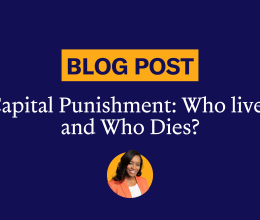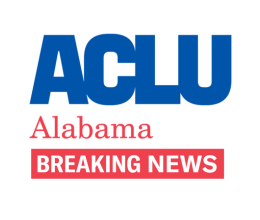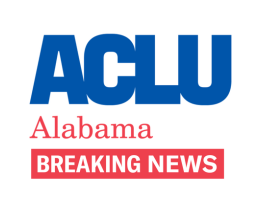
In early July, we wrote a letter alongside the Southern Poverty Law Center, Alabama Arise, and the Alabama Justice Initiative. This letter to the Director of the Alabama Bureau of Pardons and Parole is our commentary on the 2025 Proposed Changes to the Board of Pardons and Paroles. We appreciate the Bureau’s decision to update the guidelines for release and are grateful for the opportunity for the public to engage and affect the outcome.
Subject: Proposed Regulation 640-X-A-2
Dear Director Ward:
Thank you for the opportunity to comment on the 2025 Proposed Changes to the Board of Pardons and Paroles (hereafter, referred to as “The Board”) voluntary parole guidelines. The Board’s recent past shows a need for significant reforms, and an update to the release guidelines and procedures gives an opportunity to make beneficial, necessary changes. The undersigned advocates to this public comment, who range from attorneys who have provided direct representation to criminal justice policy researchers to peer-to-peer support providers, see this statutorily overdue rulemaking review process as an opportunity to make positive changes that properly balance the genuine public safety needs with metrics more directly correlated to rehabilitative success. To fully seize this opportunity and capitalize on the recent efforts and investment to achieve the Reentry 2030 goals of the Legislature and the Alabama Reentry Task Force (formerly the Alabama Reentry Commission), we believe the proposed regulation warrants changes to improve the Board’s parole application review process. The following revisions reflect some of the more significant changes that the Board should take into account before finalizing the new guidelines.
Beginning in Section I, the Board’s proposed changes to the severity of risk calculation should not include a point for petitioners assessed as low-risk. The point structure for offense severity should instead read:
Low - 0
Moderate - 1
High - 2
This modification is warranted for two reasons. First, because the aim of this process is to assess fitness for release, assessing a point against offenders whose offenses were of low severity cuts directly against the purpose of the parole process. The parole hearing application process is not a forum to relitigate the underlying offense - the sentence the applicant is currently serving. The process is meant to assess and determine the individual’s “status” of rehabilitation. That said, “Low” offense severity has been shown to be a statistically significant positive indicator of fitness for release and accordingly should not result in a negative consequence for petitioners. Second, the increased point assessments across all severity classifications in addition to the new “Very high” category serve only to tilt the process against release. The offense categories have no bearing on current public safety concerns at all and serve only to retry the cases for which petitioners are serving sentences. We ask you not to make this portion of the parole process less functional by increasing the points assessments, including by assessing points against low-severity petitioners.
Next, Section III: Institutional Behavior should be modified to read as follows:
0-1 non-violent disciplinaries within last 12 months -1
Multiple disciplinaries without instigating violence in 1
last 12 months
One disciplinary where petitioner instigated physical 2
violence without causing serious injury within last 12
months
Two disciplinaries where petitioner instigated physical 3
violence without causing serious injury within last 12
months
More than two disciplinaries where petitioner instigated 4
physical violence OR one or more disciplinaries where
petitioner instigated violence and caused severe injury
within last 12 months
This change would provide a consistent points escalation system directly proportional to the severity of conduct. The wording change also would reduce the likelihood, as unfortunately can happen now, of petitioners facing lower likelihood of parole when the applicant is neither the aggressor nor instigator of a reported incident. Given the undisputedly violent conditions inside Alabama’s correctional facilities, it would be unreasonable and cruel to house individuals in these settings and then punish them for defending themselves by assessing points for the mere act of survival. Particularly in a state that boasts one of the broadest “Stand Your Ground” laws in the country, it makes no sense to punish people who are forced to defend themselves because the State failed to protect them. Being the victim of carceral violence does not make a person a worse candidate for release, and petitioners should not have points assessed against them when they are attacked. Moreover, revising the point designation from “0” to “-1” properly rewards and incentivizes applications who have managed to maintain a clear record. This shift not only serves the applicant, but also has the added component of aiding correctional staff in their roles of maintaining safety within the facility.
Consideration of the applicant’s participation in risk-reducing programming and their reentry plan, Sections IV and V, respectively, are largely consistent with the goals of the Bureau, but minor modifications should be made to account for the realities of programming availability. In Section IV, “Completion of required programs” should be replaced with “Completion of required programs, or shortfall attributable to program availability.” “Deficient programming” should be replaced with “Deficient programming resulting from petitioner’s avoidable failure to complete available programming.” In Section V, the chart should read as follows:
Complete, acceptable, or substantive reentry plan 0
Reentry plan submitted, with notable deficiencies 1
No reentry plan 2
This structure would be preferable because it reflects the reality that reentry plans cannot always be completed before release, and many times people need to operate outside prison to rebuild certain aspects of their lives. For example, petitioners often have difficulty finding work because of the stigma of a conviction. A petitioner is no worse a candidate for release if their employment plan is “I will seek employment in food service or landscaping” than if they already have a job available at a fast food restaurant or lawn service, but the reality may be that they cannot find that job while in prison.
Section VI’s focus on stakeholder and community input should be amended to more accurately reflect the quality and quantity of input offered as follows:
Support only -1
No input, or equal support and 0
opposition
Minimal support with 1
significant opposition
Opposition only 2
Applicants for whom there is no opposition should receive the benefit of the community support they have organized and presented to the Board. If there is no input or relatively balanced input of support and opposition presented to the Board, that, too, should be appropriately reflected in the applicant’s score. Our suggestions also would provide for instances when the community input is markedly in opposition.
In addition to these proposed factors, we also observe that the Board’s proposed guidelines lack the necessary consideration of a few significant factors correlated to a reduced likelihood of recidivism. First, a category should be added to provide a 1-point benefit to petitioners who hold work release jobs for more than six continuous months. As alluded to above, every day, hundreds of individuals under Department of Corrections custody are deemed “safe” enough to be released into communities across the state to work as linemen, do landscape maintenance, and take our drive-through orders. Many of these same individuals are then summarily denied when they come up for parole. The guidelines form should have a designated section that speaks to, and properly acknowledges, their progress in reintegrating into the broader community.
Secondly, because propensity and ability to commit crime both reliably decrease with age and physical capacity, petitioners should be assessed points favorably based upon age and health status at time of petition. Petitioners more than 60 years old should benefit from a 1-point deduction, petitioners more than 70 years old should be deducted 2 points, and petitioners more than 80 years old should be deducted 3 points. Similarly, individuals with debilitating health complications should receive a 1-point deduction.
The proposed rule is also inadequate because it lacks accountability provisions for Board votes. The release guidelines should be presumptive, not advisory. During the trial and sentencing phases, all parties are aware of what factors are determinative and possess the opportunity for input, and the judge still retains the ability to deviate if the circumstances warrant - with an articulated justification. Likewise, if this change were implemented, the Board could still choose to deviate from the set guidelines by explaining the factors that led to its decision. This would provide overdue clarity to the process for all stakeholders and remove the appearance of arbitrariness and capriciousness.
One aspect of parole decisions recently under discussion in committee hearings has been the impact on victims and families of the current process. Instead of this repetitive process, the Board should incorporate victim input without the burden of return trips to hearings by structuring victim input as a written statement to be incorporated into the file.
Finally, the overall posture determined by the points system needs to change. 0-8 points should support release. It is inappropriate for the guidelines to have a neutrality option when the only two results available to petitioners are release or denial. Moreover, given the Board’s recent actions and posture, it is unacceptably likely that voting members will view neutrality as a blanket justification for denial of release. The draft regulation’s increase in points assessed for certain circumstances, combined with a Board that has failed to follow its own procedures, demonstrate that the proposed regulation as drafted would risk becoming political cover for the Board to act just as it has in recent history, against the interests of justice, economy, and accountability. These suggested changes to the rule would mitigate these risks.
We appreciate the Bureau’s decision to update the guidelines for release and are grateful for the opportunity for the public to engage and affect the outcome. These new guidelines have importance far beyond political expedience, as these new rules must adequately safeguard the liberty interests of the thousands of people who will operate under the Bureau’s policies and procedures and ensure that the decisions made in the name of public safety are driven by sound and proven metrics. We thank you for your consideration of our input into this process.
Sincerely,
Southern Poverty Law Center
Alabama Arise
Alabama Justice Initiative
ACLU of Alabama





